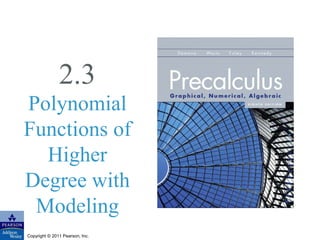More Related Content
More from Mark Ryder (20)
Unit 2.3
- 2. What you’ll learn about
Graphs of Polynomial Functions
End Behavior of Polynomial Functions
Zeros of Polynomial Functions
Intermediate Value Theorem
Modeling
… and why
These topics are important in modeling and can be used
to provide approximations to more complicated
functions, as you will see if you study calculus.
Copyright © 2011 Pearson, Inc. Slide 2.3 - 2
- 3. The Vocabulary of Polynomials
Each monomial in the sum anxn ,an1xn1,...,a0
is a term of the polynomial.
A polynomial function written in this way, with terms
in descending degree, is written in standard form.
The constants an ,an1,...,a0 are the coefficients of
the polynomial.
The term anxn is the leading term, and a0 is the
constant term.
Copyright © 2011 Pearson, Inc. Slide 2.3 - 3
- 4. Example Graphing Transformations
of Monomial Functions
Describe how to transform the graph of an appropriate
monomial function f (x) anxn into the graph of
h(x) (x 2)4 5.
Sketch h(x) and compute the y-intercept.
Copyright © 2011 Pearson, Inc. Slide 2.3 - 4
- 5. Example Graphing Transformations
of Monomial Functions
You can obtain the graph of
h(x) (x 2)4 5 by
shifting the graph of
f (x) x4 two units to
the left and five units up.
The y-intercept of h(x)
is h(0) 24
5 11.
Copyright © 2011 Pearson, Inc. Slide 2.3 - 5
- 8. Local Extrema and Zeros of
Polynomial Functions
A polynomial function of degree n has at most
n – 1 local extrema and at most n zeros.
Copyright © 2011 Pearson, Inc. Slide 2.3 - 8
- 9. Leading Term Test for Polynomial
End Behavior
For any polynomial function f (x) anxn ... a1x a0 ,
the limits lim
x
f (x) and lim
x
f (x) are determined by the
degree n of the polynomial and its leading
coefficient an :
Copyright © 2011 Pearson, Inc. Slide 2.3 - 9
- 10. Leading Term Test for Polynomial
End Behavior
Copyright © 2011 Pearson, Inc. Slide 2.3 - 10
- 11. Leading Term Test for Polynomial
End Behavior
Copyright © 2011 Pearson, Inc. Slide 2.3 - 11
- 12. Example Applying Polynomial
Theory
Describe the end behavior of g(x) 2x4 3x3 x 1
using limits.
Copyright © 2011 Pearson, Inc. Slide 2.3 - 12
- 13. Example Applying Polynomial
Theory
Describe the end behavior of g(x) 2x4 3x3 x 1
using limits.
lim
x
g(x)
Copyright © 2011 Pearson, Inc. Slide 2.3 - 13
- 14. Example Finding the Zeros of a
Polynomial Function
Find the zeros of f (x) 2x3 4x2 6x.
Copyright © 2011 Pearson, Inc. Slide 2.3 - 14
- 15. Example Finding the Zeros of a
Polynomial Function
Find the zeros of f (x) 2x3 4x2 6x.
Solve f (x) 0
2x3 4x2 6x 0
2xx 1x 3 0
x 0, x 1, x 3
Copyright © 2011 Pearson, Inc. Slide 2.3 - 15
- 16. Multiplicity of a Zero of
a Polynomial Function
If f is a polynomial function and x cm
is a factor of f but x cm1
is not,
then c is a zero of multiplicity m of f .
Copyright © 2011 Pearson, Inc. Slide 2.3 - 16
- 17. Zeros of Odd and Even Multiplicity
If a polynomial function f has a real zero c of
odd multiplicity, then the graph of f crosses the
x-axis at (c, 0) and the value of f changes sign at
x = c. If a polynomial function f has a real zero c
of even multiplicity, then the graph of f does not
cross the x-axis at (c, 0) and the value of f does
not change sign at x = c.
Copyright © 2011 Pearson, Inc. Slide 2.3 - 17
- 18. Example Sketching the Graph of a
Factored Polynomial
Sketch the graph of f (x) (x 2)3(x 1)2 .
Copyright © 2011 Pearson, Inc. Slide 2.3 - 18
- 19. Example Sketching the Graph of a
Factored Polynomial
Sketch the graph of f (x) (x 2)3(x 1)2 .
The zeros are x 2 and x 1.
The graph crosses the x-axis at
x 2 because the multiplicity
3 is odd. The graph does not
cross the x-axis at x 1 because
the multiplicity 2 is even.
Copyright © 2011 Pearson, Inc. Slide 2.3 - 19
- 20. Intermediate Value Theorem
If a and b are real numbers with a < b and if f is
continuous on the interval [a,b], then f takes on
every value between f(a) and f(b). In other
words, if y0 is between f(a) and f(b), then y0=f(c)
for some number c in [a,b].
In particular, if f(a) and f(b) have opposite signs
(i.e., one is negative and the other is positive,
then f(c) = 0 for some number c in [a, b].
Copyright © 2011 Pearson, Inc. Slide 2.3 - 20
- 22. Quick Review
Factor the polynomial into linear factors.
1. 3x2 11x 4
2. 4x3 10x2 24x
Solve the equation mentally.
3. x(x 2) 0
4. 2(x 2)2 (x 1) 0
5. x3(x 3)(x 5) 0
Copyright © 2011 Pearson, Inc. Slide 2.3 - 22
- 23. Quick Review Solutions
Factor the polynomial into linear factors.
1. 3x2 11x 4 3x 1x 4
2. 4x3 10x2 24x 2x2x 3x 4
Solve the equation mentally.
3. x(x 2) 0 x 0, x 2
4. 2(x 2)2 (x 1) 0 x 2, x 1
5. x3(x 3)(x 5) 0 x 0, x 3, x 5
Copyright © 2011 Pearson, Inc. Slide 2.3 - 23

